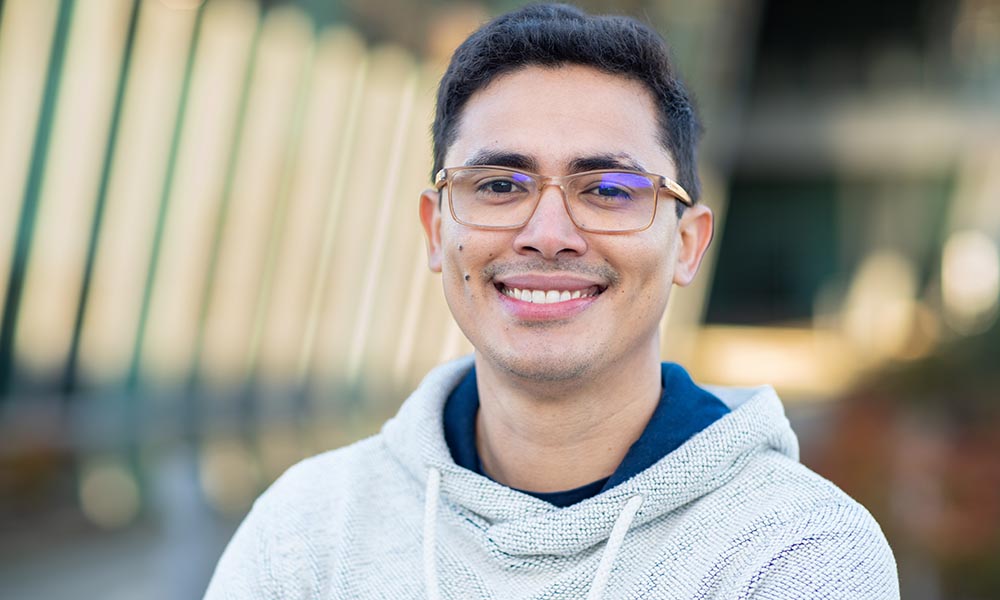
We are EMBL: Iguaracy Pinheiro-de-Sousa on organoids and nanorobot ‘highways’
Postdoctoral researcher Iguaracy Pinheiro de Sousa is using bioinformatics to support the development of better organoids

The intricacies of how different types of cells interact to create a tissue still hold many unknowns. As more single-cell data become available through projects such as the Human Cell Atlas, researchers are gaining another lens through which to explore these questions.
Iguaracy Pinheiro-de-Sousa is a postdoctoral fellow in the Petsalaki group at EMBL-EBI. He uses bioinformatics to understand cell interactions and improve the development of organoids.
What is your background?
I’m originally from Brazil and I went to biomedical school, focusing on genetics and molecular biology. I did my PhD at the Heart Institute, at the University of São Paulo, in the Krieger group, where I focused on how different cardiovascular risk factors contribute to the accumulation of fatty plaques in the coronary arteries, a key process that can lead to heart attacks. Specifically, I studied endothelial cells, which line the surface of blood vessels. I used to do wet lab experiments to simulate blood flow, with the specific focus of understanding how endothelial dysfunction leads to accumulation of fat in the blood vessel walls.
I later transitioned into more computational work because I was interested in going beyond the specifics of the heart and understanding the bigger picture. I thought that bioinformatics and the use of omics data were good starting points for this.
How did you get interested in science?
I had a great biology teacher who would talk to us about weird and wonderful things, such as bioengineering, for example. I found these things fascinating and wanted to learn more about them.
Can you briefly describe the work you do at EMBL-EBI?
The majority of my work focuses on using single-cell transcriptomics data to understand how different types of cells interact and communicate to form a tissue. This has many applications, from understanding the basic biology of how cells and tissues work, to more practical things, such as the development of organoids.
Organoids are miniaturised 3D tissue cultures, derived from stem cells, and designed to mimic the structure and function of different organs. They enable the study of human biology and support drug discovery. At the moment, organoids have many limitations, and are unable to capture the complexity of interactions found in the body.
By using single-cell data to better understand the inner workings of cell function, and how cells communicate within tissues, we could gain a better understanding of how to develop organoids that simulate the complexity of real organs.
How important do you think collaboration is in your work?
For me, science is highly collaborative work. Working with others results in more creative approaches, better problem solving and often saves time.
I think the only way to make progress in organoid research is for computational and wet lab scientists to work together. The idea is to bring together deep computational, data analysis, single-cell, biological and medical expertise to try and paint a comprehensive picture of what is happening at the cell level and how it can be mimicked within organoids.
My background is in cardiovascular disease, so this is the area where I understand the biology best, and this is the kind of data I usually work with. I’m also collaborating with Kristina Haase at EMBL Barcelona on this. In addition, I’ve also set up a collaboration with colleagues at Yale looking at the brain, and specifically the differences in signalling pathways between what happens at a cellular level in healthy brains compared to brains affected by Alzheimer’s disease.
Where do you get your inspiration?
Talking to others – from within and outside your area of expertise – often helps when you get stuck, and gives you new ideas.
For example, a few years ago I attended a talk about molecular machines and nanorobots presented by the Nobel laureate Fraser Stoddart, and it got me thinking about ways of getting the nanobots to the right place in the body. Because my background is in cardiovascular research, I started to think about how you could use the blood vessels to make the delivery of nanobots more targeted and precise. This is one of the things that is missing in traditional drug treatments. When you take a pill, it needs to have a big enough chemical dose to make its way through the entire body and hopefully get to the affected area. But with nanobots and precision medicine, things could get a lot more precise. So one of my side projects at the moment is looking at this.
What other things take up your time?
I want to create opportunities for PhDs and postdocs at EMBL to interact and exchange ideas, so with two of my colleagues, Ellen Cameron and Daniel O’Hanlon, we’ve come up with a new internal seminar series called Biobytes, which focuses on disruptive concepts and ideas from the wider scientific sphere, for example supernovas, the concept of time travel in quantum mechanics etc. The idea is to tickle people’s creativity and get people talking in a more informal context.


